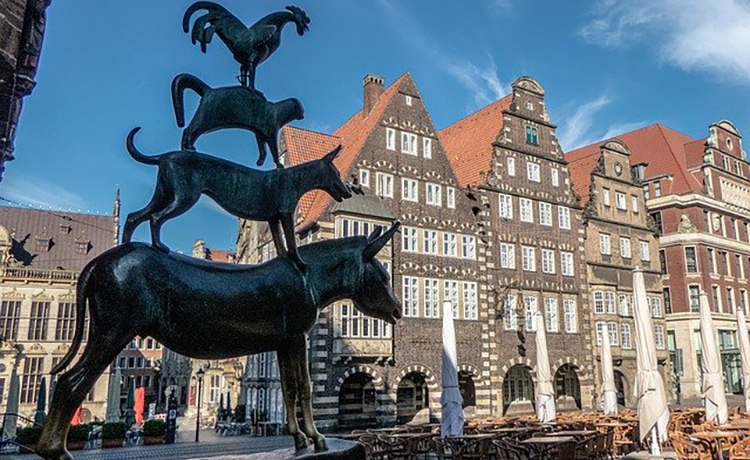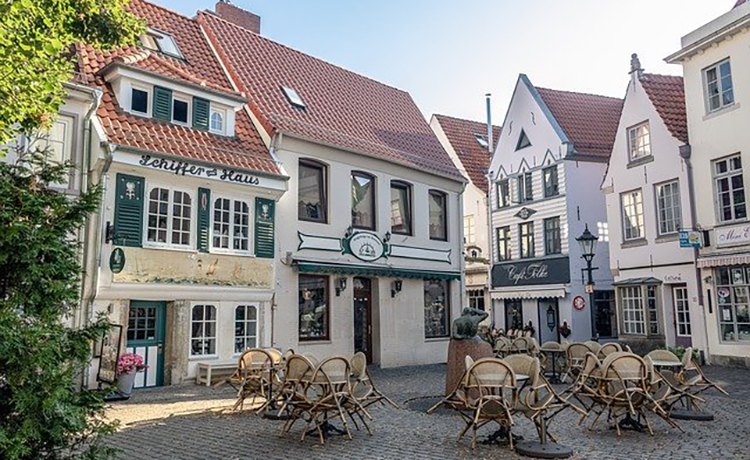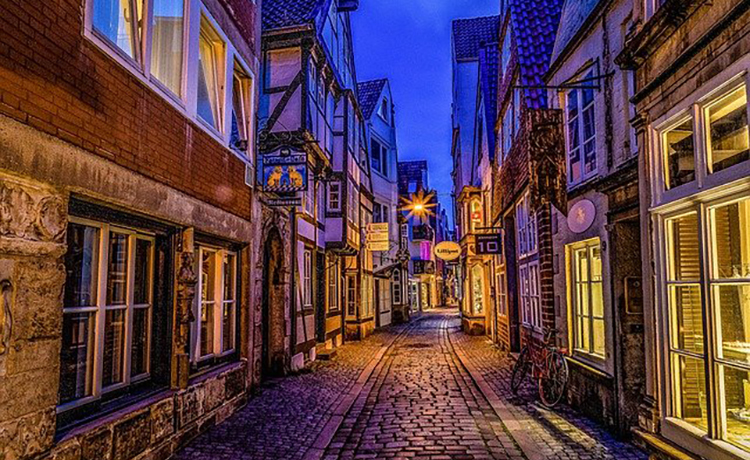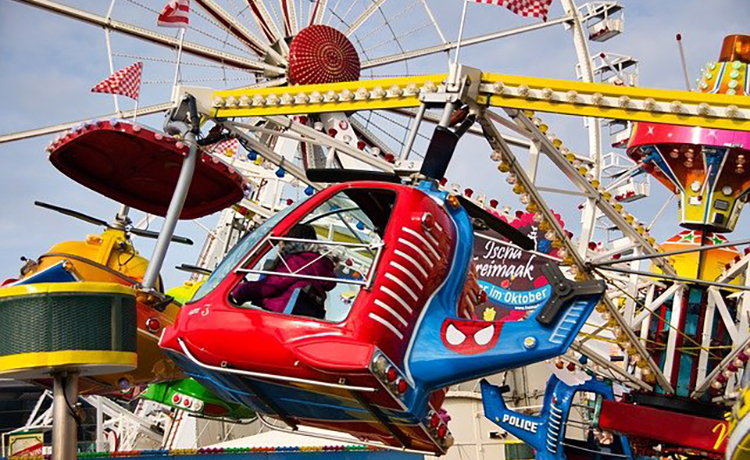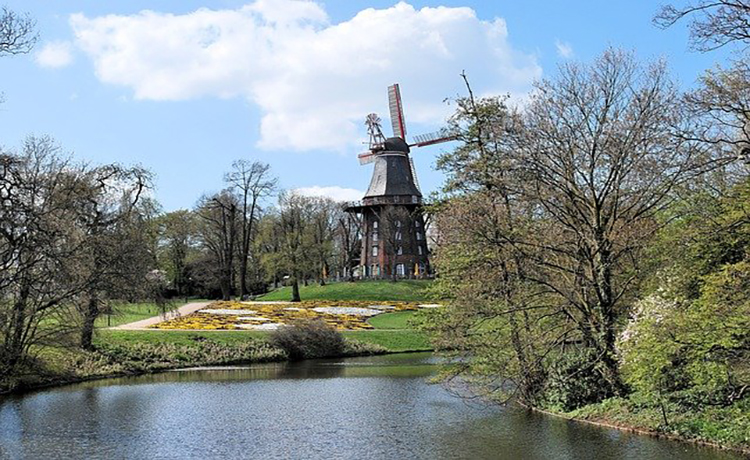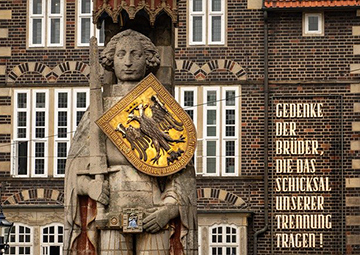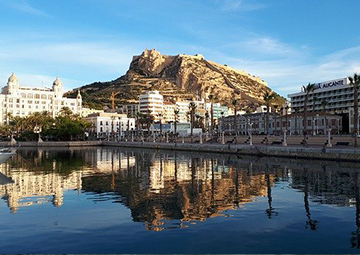Bremen, The Hanseatic City'
Bremen is a city and municipality in Bremen and the capital of the Free Hanseatic City (Bremen's Free Hanseatic City, Bremen's two city states, consisting of the cities Bremen and Bremerhaven. With 570,000 inhabitants, it is the second largest city in Germany after the largest city in northern Germany, Hamburg. The Bremen, Oldenburg and Bremerhaven commercial and industrial cities are part of the Bremen-Oldenburg metropolitan area with 2.5 million inhabitants. Bremen is the third largest town on the Weser, the longest river that flows through Germany. It is about 60 km upstream of its mouth in the North Sea and surrounded by the state of Lower Saxony. It borders the Saxon cities of Delmenhorst, Stuhr, Achim, Weyhe, Schwanewede and Lilienthal.
Bremen is an important cultural and economic centre of northern Germany. After Hamburg, it is the second largest city in the Lower German dialect area, after Dortmund-Essen. Bremen Airport (Bremen Hans-Koschnick), located in the southern district of Neustadt in the Neuenland region, is Germany's 12th busiest airport. Bremen Harbour, the Port of Bremerhaven at the mouth of the Weser, is Germany's third largest port after the Port of Hamburg. The exclave Bremen (Bremerhaven-Citybremian) is an overseas port area of the city, the Stadtbremische Uberseehafengebiet Bremer Haven. Bremens capital is the largest city in the Lower German dialect area between Hamburg, Dortmund and Essen.
The city has dozens of historic galleries and museums ranging from historical sculptures to important art museums such as the Bremen Ubersee Museum and the Bremen Ubersee Museum. The city is also home to many multinational companies and is a manufacturing center. Companies headquartered in the city include the chocolate company Hachez, Vector and Foiltec. The town is known for the fairy tale of the Brothers Grimm about the town and the musicians of the "Bremer Stadtmusikanten" and the statue dedicated to them in front of the town hall. It has a reputation as a working-class town.
The most famous football club in the city is the 2.Bundesliga club SV Werder B Remen, which plays in the Weserstadion on the Weserufer.
History
For most of Bremen's 1200-year history, it was an independent city under the confederal jurisdiction of the Holy Roman Empire of Germany. It was ruled by a merchant's guild and was the centre of the Hanseatic League, which wanted to monopolise trade on the North and Baltic Seas. Enlarged and confirmed in its independence, during the Reformation Bremen had to contend with the secular power of the Church during the Thirty Years "War with Sweden, the lord of the surrounding Duchy of Barmen and Verden.
In the late 19th century, Bremen was drawn into Prussia and the German Reich. With its new anchorage and quay in Bremerhaven, it was the most important port of embarkation for German and Central European emigrants to America and the entrepreneurs of the developing colonial trade in Germany.
The Norddeutsche Lloyd (NDL) was founded in Bremen in 1857 and soon developed into one of the world's leading shipping companies. In the 20th century, the city lost its autonomy to the Hitler regime. During the Second World War, two thirds of the Bremen fabric was destroyed, but the autonomy of the cities was eventually restored. It became a unique founding state of the Federal Republic.
Unique, friendly and open to everyone. This is the Bürgerpark in Bremen. And that's exactly how he welcomes everyone who wants to find peace and relaxation or relaxation through activities in nature in the middle of the big city. Bürgerpark Bremen
Sightseeing
Many attractions of Bremen can be found in the old town, an oval area around the Weser in the southwest, and in the northeast in the Wallgraben, a former moat of the medieval city wall. The oldest part of the city is the southeastern half, which begins at the market square and ends at the Schnoorviertel.
The market square is dominated by the opulent façade of Bremen's town hall. It was built between 1405 and 1410 in Gothic style and two centuries later, in 1609-12, in Renaissance style. It is the seat of the President of the Senate of the city.
Twelve of the oldest wines in the world are stored in their original barrels in the Apostle's Chamber. In July 2004, the town hall was included in the UNESCO World Heritage List together with Bremen and Roland. Today it houses a restaurant with an original décor, the huge wine barrel Ratskeller Bremen wine list, which contains more than 600 German wines.
On the west side of the town hall stand two statues - one is those of Bremen (1404), the city's guard Roland (seemed from the Cathedral with the Durendart sword of justice) with a shield adorned with an imperial eagle. The other stands at the entrance to the Ratskeller, Gerhard Marck's bronze sculpture (1953) Die Stadtmusikanten, which depicts a donkey, a dog, a cat and a cock from the fairy tale of the Brothers Grimm.
Other interesting buildings near the market are the Schutting, a Flemish guild parlour from the 16th century, the Rathscafe (Rath Apotheke), the Haus der Stadtsparkasse (Stadtwaage), a former Waagenhaus with an ornate Renaissance facade built in 1588, and the nearby Essighaus, a fine Renaissance townhouse. The facades of the houses around the market square were among the first buildings in Bremen to be restored by the citizens of the city themselves after the Second World War.
S Basilica (13th century) east of the square with sculptures of Moses, David, Peter, Paul and Charlemagne. The Bismark monument in the cathedral is the only monument in Germany that represents the Bismark in equestrian format.
The Church of Our Lady is the oldest church in the city from the 11th century. In the crypt there are several impressive murals from the 14th century. In the Katherinenklosterhof, northwest of the cathedral, there are the few remaining traces of the Katherinenklosterhof from the 13th century.
It was regarded by the Nazis as degenerate art. On the south side of the square, the 110 m long Bottcherstraße was redesigned between 1923 and 1931, when coffee magnate Ludwig Roselius commissioned local artists to transform it into an inspired mix of Gothic and Art Nouveau. Today, next to the Glockenspielhaus, it is one of Bremen's most popular attractions.
At the end of Bottcherstraße, on the banks of the Weser, stands the Martinikirche, a Gothic brick church from 1229, which was rebuilt in the 1960s after its destruction in the Second World War. The monastery of St. Bridget, founded in 2002 by a small community of seven nuns, offers overnight accommodation. Behind the church lies the Weser Schnoor, a small, preserved area with leaning alleys and fishermen's houses from the 17th and 18th centuries, which is now inhabited by cafés, craft shops and an art gallery.
The district east of the old town combines lines from 19th-century Bremen and houses the Bremer Hauser Museum, the Theater des Theater Bremen and the Kulturmeile Barmen-de. Schlachte, the medieval harbour of the modern city harbour, is one kilometre long and today it is a waterfront promenade with pubs and bars, oriented on one side with the Weser riverbank on the other.
Another option is to rent a small rowing boat in the middle of Knoops Park, one of the largest green spaces in the city and something many locals like to visit. The park is best when the weather is warm.
The Nasir Mosque is the first dedicated mosque of the Ahmadiyya community in Bremen. The Weserburg Museum of Modern Art is a museum of modern art in the middle of the Weser. There is also the Ubersee Museum (Bremer Übersee), the World Museum of Natural History, the Ethnographic Museum and the main railway station of the city.
Events
During the last two weeks of October, the city hosts the Open Market (Freimarkt), one of the oldest fairs in the world and one of the largest and most celebrated fairs of our time.




